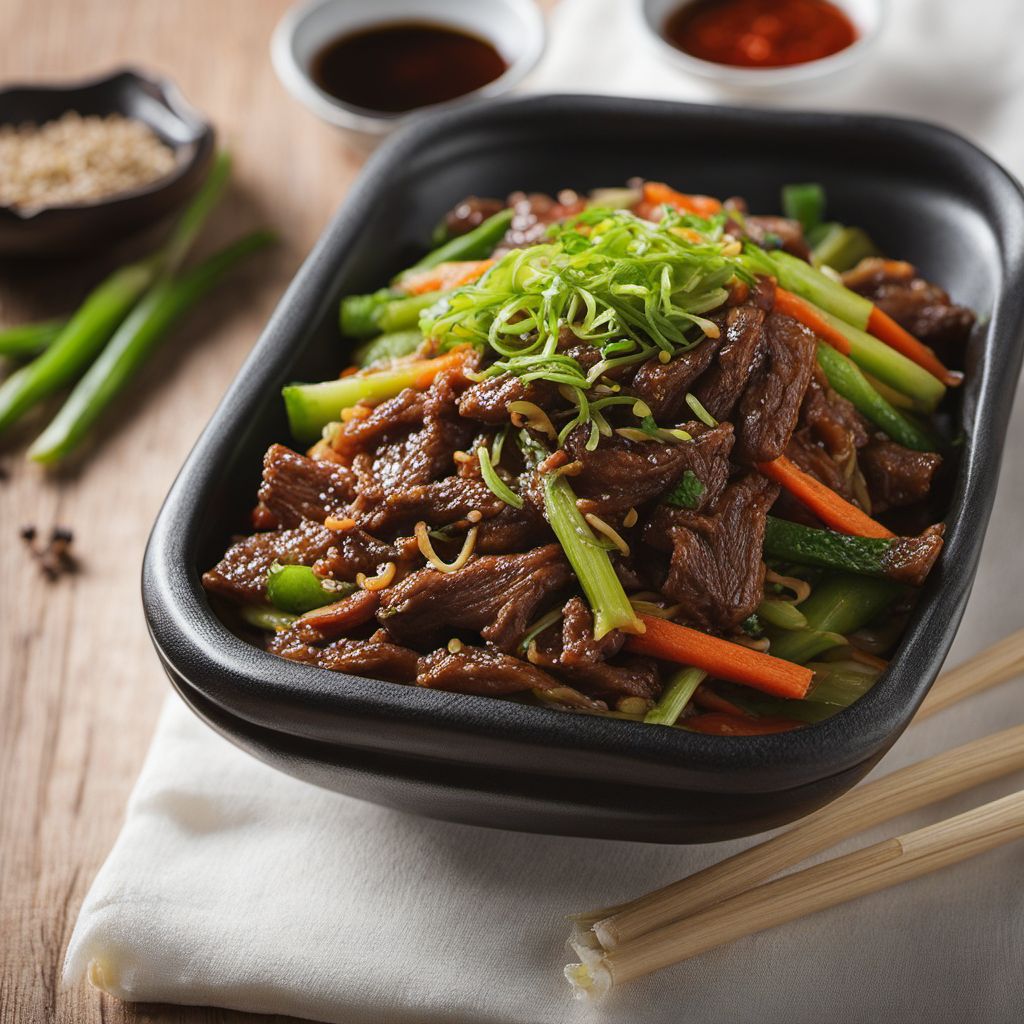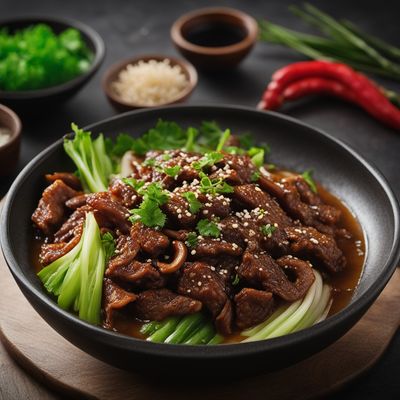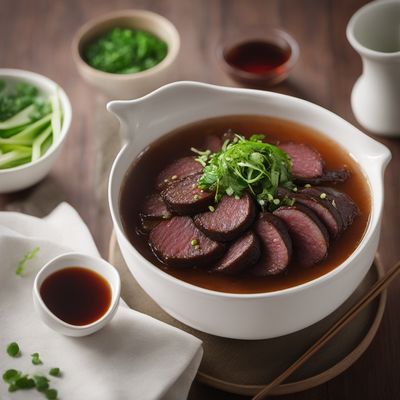
Recipe
Jjapaguri with Sautéed Beef and Vegetables
Savory Fusion: Korean Jjapaguri with a Twist
4.7 out of 5
This recipe is a delightful fusion of traditional Korean flavors and modern culinary techniques. Jjapaguri, a popular Korean dish, is elevated with the addition of sautéed beef and vegetables, creating a satisfying and flavorful meal.
Metadata
Preparation time
20 minutes
Cooking time
15 minutes
Total time
35 minutes
Yields
4 servings
Preparation difficulty
Medium
Suitable for
Omnivore, Pescatarian, Dairy-free, Nut-free, Egg-free
Allergens
Soy, Shellfish (if using oyster sauce)
Not suitable for
Vegetarian, Vegan, Gluten-free, Paleo, Keto
Ingredients
-
2 packs (400g) of instant jjapaguri noodles 2 packs (400g) of instant jjapaguri noodles
-
200g beef, thinly sliced 200g beef, thinly sliced
-
1 tablespoon vegetable oil 1 tablespoon vegetable oil
-
1 onion, thinly sliced 1 onion, thinly sliced
-
1 carrot, julienned 1 carrot, julienned
-
1 zucchini, julienned 1 zucchini, julienned
-
4 tablespoons soy sauce 4 tablespoons soy sauce
-
2 tablespoons oyster sauce 2 tablespoons oyster sauce
-
1 tablespoon sugar 1 tablespoon sugar
-
1 teaspoon sesame oil 1 teaspoon sesame oil
-
1 teaspoon minced garlic 1 teaspoon minced garlic
-
1 teaspoon gochugaru (Korean red pepper flakes) 1 teaspoon gochugaru (Korean red pepper flakes)
-
2 cups (470ml) water 2 cups (470ml) water
-
Salt, to taste Salt, to taste
-
Chopped green onions, for garnish Chopped green onions, for garnish
Nutrition
- Calories (kcal / KJ): 450 kcal / 1884 KJ
- Fat (total, saturated): 12g, 3g
- Carbohydrates (total, sugars): 60g, 8g
- Protein: 25g
- Fiber: 5g
- Salt: 2g
Preparation
-
1.Cook the instant jjapaguri noodles according to the package instructions. Drain and set aside.
-
2.In a large skillet, heat the vegetable oil over medium-high heat. Add the sliced beef and cook until browned. Remove the beef from the skillet and set aside.
-
3.In the same skillet, add the onion, carrot, and zucchini. Sauté until the vegetables are tender.
-
4.In a small bowl, whisk together the soy sauce, oyster sauce, sugar, sesame oil, minced garlic, and gochugaru.
-
5.Return the beef to the skillet with the sautéed vegetables. Pour the sauce over the beef and vegetables, and stir to coat evenly.
-
6.Add the cooked jjapaguri noodles to the skillet and toss everything together until well combined.
-
7.Pour in the water and cook for an additional 2-3 minutes, allowing the flavors to meld together. Season with salt to taste.
-
8.Serve the Jjapaguri with Sautéed Beef and Vegetables in bowls, garnished with chopped green onions.
Treat your ingredients with care...
- Jjapaguri noodles — Be careful not to overcook the noodles as they can become mushy. Follow the package instructions for the best results.
- Beef — Thinly sliced beef cooks quickly, so make sure not to overcook it to maintain its tenderness.
- Gochugaru — Adjust the amount of gochugaru according to your spice preference. Add more for a spicier dish or reduce it for a milder flavor.
Tips & Tricks
- For a vegetarian version, you can substitute the beef with tofu or mushrooms.
- Customize the vegetable selection based on your preference and seasonal availability.
- Add a fried egg on top of each serving for an extra touch of richness.
- Adjust the sauce ingredients to suit your taste preferences.
- Leftovers can be stored in the refrigerator for up to 2 days and reheated before serving.
Serving advice
Serve the Jjapaguri with Sautéed Beef and Vegetables hot, straight from the skillet. Garnish with chopped green onions for added freshness and color.
Presentation advice
Present the Jjapaguri with Sautéed Beef and Vegetables in individual bowls, allowing the vibrant colors of the sautéed vegetables to shine through. The noodles should be well-coated with the savory sauce, and the dish should be garnished with a sprinkle of chopped green onions for an appealing finishing touch.
More recipes...
More Korean cuisine dishes » Browse all

Honghap tang
Spicy seafood soup
Honghap tang is a traditional Korean soup that is made with mussels and vegetables. The soup is known for its rich and savory flavor, and is...

Dakbokkeumtang
Dakbokkeumtang is a Korean dish that is made with spicy chicken stew. It is a popular dish in Korea and is often served in restaurants and at home.

Samgyetang
Samgyetang is a traditional Korean dish made with a whole chicken that is stuffed with rice, ginseng, and other herbs. It is a hearty and...






